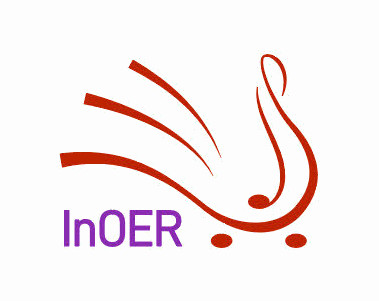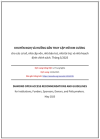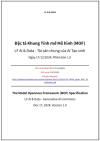Windowshole discovered after 17 years - Up-date
20January 2010, 13:36
Bàiđược đưa lên Internet ngày: 20/01/2010
Lờingười dịch: Chúng ta từng được biết thông tin vềviệc số lượng lỗi sống còn trong hệ điều hành phầnmềm tự do nguồn mở RedHat Enterprise Linux cả phiên bản 4.0 và 5.0 là bằng 0,còn bây giờ ta biết thêm rằng trong Microsoft Windows cólỗi đã 17 năm nay bây giờ mới được phát hiện.
Microsoftkhông có được thời khắc dễ dàng những ngày này. Bổsung cho lỗ thủng còn chưa được vá trong InternetExplorer, một lỗ thủng bây giờ được phát hiện trongWindows cho phép người sử dụng với quyền hạn chế leolên được các quyền ưu tiến của họ ở mức hệ thống- và điều này được tin là có thể có trên tất cảcác phiên bản 32 bit của Windows từ Windows NT 3.1 cho tới,và bao gồm cả Windows 7. Trong khi tính có thể bị tổnthương này hình như sẽ ảnh hưởng tới những ngườisử dụng ở nhà chỉ là không đáng kể, thì các quảntrị viên ở các mạng doanh nghiệp có lẽ sẽ phải bậnrộn suốt tuần này.
Vấnđề này được gây ra bởi những lỗi trong Máy Ảo DOS(VDM) được giới thiệu vào năm 1993 để hỗ trợ cácứng dụng 16 bit (các ứng dụng ở chế độ thực cho8086). VDM được dựa trên chế độ Ảo 8086 (VM86) trongcác vi xử lý 80386 và, chặn các thủ tục phần cứngnhư các lời gọi BIOS. Thành viên độian ninh của Google Tavis Ormandy đã thấy vài chỗ bị tổnthương trong triển khai này mà chúng cho phép một chươngtrình 16 bit không có quyền sẽ điều hành được kho củanhân đối với mỗi quá trình thông qua một số lượngcác mẹo. Điều này cho phép một cách tiềm tàng nhữngkẻ tấn công chạy các mã nguồn ở mức ưu tiên của hệthống.
Ormandycũng đã đưa ra một khai thác phù hợp mà nó hoạt độngtrong Windows XP, Windows Server 2003 và 2008, Windows Vista vàWindows 7. Khi được thử nghiệm bởi TheH's associates at heise Security, sự khai thác đã mở một lờinhắc lệnh theo ngữ cảnh của hệ thống, mà nó có mứcquyền cao nhất, trong Windows XP và Windows 7. Chưa từng cóbản vá nào sẵn sàng, dù Ormandy nói rằng Microsoft đãđược thông tin về lỗ hổng này từ giữa năm 2009. Lậptrình viên này đã quyết định công bố thông tin này vì,theo ý kiến của anh ta, có một cách khắc phục đơngiản: vô hiệu hóa hệ thống phụ của MS-DOS.
Microsoftisn't having an easy time of it these days. In addition to theunpatchedhole in Internet Explorer, a now published hole in Windows allowsusers with restricted access to escalate their privileges to systemlevel – and this is believed to be possible on all 32-bit versionsof Windows f-rom Windows NT 3.1 up to, and including Windows 7. Whilethe vulnerability is likely to affect home users in only a minor way,the administrators of corporate networks will probably have theirhands full this week.
Theproblem is caused by flaws in the VirtualDOS Machine (VDM) introduced in 1993 to support 16-bitapplications (real mode applications for 8086). VDM is based on theVirtual 8086 Mode (VM86) in 80386 processors and, among other things,intercepts hardware routines such as BIOS calls. Google security teammember Tavis Ormandy has found several vulnerabilities in thisimplementation that allow an unprivileged 16-bit program tomanipulate the kernel stack of each process via a number of tricks.This potentially enables attackers to execute code at systemprivilege level.
Ormandyhas also published a suitable exploit which functions under WindowsXP, Windows Server 2003 and 2008, Windows Vista and Windows 7. Whentested by the The H's associates at heise Security, the exploitopened a command prompt in the system context, which has the highestprivilege level, under Windows XP and Windows 7. No patch has becomeavailable, although Ormandy reports that Microsoft was alreadyinformed of the hole in mid 2009. The developer decided to publishthe information regardless because, in his opinion, there is a simpleworkaround: to disable the MS-DOSsubsystem.
Việckhắc phục này đòi hỏi người sử dụng phải khởi tạotrình soạn thảo chính sách nhóm và kích hoạt lựa chọn"Prevent access to 16-bit applications" (Ngăn cản truycập tới các ứng dụng 16 bit) trong khu ComputerConfiguration\Administrative Templates\Windows Components\ApplicationCompatibility. Khiđược thử nghiệm với những thiết lập này bởi độiAn ninh của heise, khai thác này không còn hoạt động đượcnữa. Các thiết lập này được cho là không gây ra bấtký vấn đề tương thích chủ chốt nào cho hầu hếtnhững người sử dụng trong khi các ứng dụng 16 bit đangđược sử dụng.
Cậpnhật - Lựa chọn ở trên chỉ sẵn sàng thông qua trìnhsoạn thảo chính sách nhóm trên Windows 2003. Một số phiênbản của Windows không có trình soạn thảo chính sáchnhóm. Như một giải pháp thay thế, người sử dụng cũngcó thể tạo một khóa đăng ký trong\HKEY_LOCAL_MACHINE\SOFTWARE\Policies\Microsoft\Windows\AppCompat vớimột giá trị của D-Word của VDMDissallowed = 1. Trong WindowsXP, để ngăn ngừa hệ thống khỏi bị tổn thương đốivới khai thác này, người sử dụng có thể đưa vào dòngsau đây:
WindowsRegistry Editor Version 5.00
[HKEY_LOCAL_MACHINE\SOFTWARE\Policies\Microsoft\Windows\AppCompat]
"VDMDisallowed"=dword:00000001
vàomột tệp được gọi là vdmdisallow.reg và nháy đúp vàotệp này. Windows sẽ sau đó tự động nhập khóa (cácquyền quản trị được yêu cầu để tiến hành hànhđộng này).
Theworkaround requires users to start the grouppolicy editor and enable the "Prevent access to 16-bitapplications" option in the ComputerConfiguration\Administrative Templates\Windows Components\ApplicationCompatibilitysection. When tested with these settings by the heise Security team,the exploit no longer functioned. The settings reportedly don't causeany major compatibility problems for most users while no 16-bitapplications are being used.
Up-date- The above option is only available through the group policy editoron Windows 2003 systems. Some versions of Windows do not include agroup policy editor. As an al-ternative, users can also cre-ate aregistry key under\HKEY_LOCAL_MACHINE\SOFTWARE\Policies\Microsoft\Windows\AppCompatwith a D-Word value of VDMDissallowed = 1. Under Windows XP, toprevent the system f-rom being vulnerable to the exploit, users canplace the following text:
WindowsRegistry Editor Version 5.00
[HKEY_LOCAL_MACHINE\SOFTWARE\Policies\Microsoft\Windows\AppCompat]
"VDMDisallowed"=dword:00000001
intoa file called vdmdisallow.reg and double click the file. Windows willthen automatically import the key (admin rights are required toperform this action).
Dịch tài liệu: LêTrung Nghĩa
Ý kiến bạn đọc
Những tin mới hơn
Những tin cũ hơn
Blog này được chuyển đổi từ http://blog.yahoo.com/letrungnghia trên Yahoo Blog sang sử dụng NukeViet sau khi Yahoo Blog đóng cửa tại Việt Nam ngày 17/01/2013.Kể từ ngày 07/02/2013, thông tin trên Blog được cập nhật tiếp tục trở lại với sự hỗ trợ kỹ thuật và đặt chỗ hosting của nhóm phát triển...
 Loạt bài về AI và AI Nguồn Mở: Công cụ AI; Dự án AI Nguồn Mở; LLM Nguồn Mở; Kỹ thuật lời nhắc;
Loạt bài về AI và AI Nguồn Mở: Công cụ AI; Dự án AI Nguồn Mở; LLM Nguồn Mở; Kỹ thuật lời nhắc;
 Các bài trình chiếu trong năm 2024
Các bài trình chiếu trong năm 2024
 Tập huấn thực hành ‘Khai thác tài nguyên giáo dục mở’ cho giáo viên phổ thông, bao gồm cả giáo viên tiểu học và mầm non tới hết năm 2024
Tập huấn thực hành ‘Khai thác tài nguyên giáo dục mở’ cho giáo viên phổ thông, bao gồm cả giáo viên tiểu học và mầm non tới hết năm 2024
 Các lớp tập huấn thực hành ‘Khai thác tài nguyên giáo dục mở’ tới hết năm 2024
Các lớp tập huấn thực hành ‘Khai thác tài nguyên giáo dục mở’ tới hết năm 2024
 Các tài liệu dịch sang tiếng Việt tới hết năm 2024
Các tài liệu dịch sang tiếng Việt tới hết năm 2024
 ‘Digcomp 2.2: Khung năng lực số cho công dân - với các ví dụ mới về kiến thức, kỹ năng và thái độ’, EC xuất bản năm 2022
‘Digcomp 2.2: Khung năng lực số cho công dân - với các ví dụ mới về kiến thức, kỹ năng và thái độ’, EC xuất bản năm 2022
 Tổng hợp các bài của Nhóm các Nhà cấp vốn Nghiên cứu Mở (ORFG) đã được dịch sang tiếng Việt
Tổng hợp các bài của Nhóm các Nhà cấp vốn Nghiên cứu Mở (ORFG) đã được dịch sang tiếng Việt
 Tổng hợp các bài của Liên minh S (cOAlition S) đã được dịch sang tiếng Việt
Tổng hợp các bài của Liên minh S (cOAlition S) đã được dịch sang tiếng Việt
 Năm Khoa học Mở & Chuyển đổi sang Khoa học Mở - Tổng hợp các bài liên quan
Năm Khoa học Mở & Chuyển đổi sang Khoa học Mở - Tổng hợp các bài liên quan
 Hội nghị Đối tác Dữ liệu Mở châu Á năm 2021 do Việt Nam lần đầu tiên chủ trì
Hội nghị Đối tác Dữ liệu Mở châu Á năm 2021 do Việt Nam lần đầu tiên chủ trì
 Phong trào Bình dân học vụ số: Mục tiêu, đối tượng, nội dung, nguồn lực, phương thức tổ chức thực hiện
Phong trào Bình dân học vụ số: Mục tiêu, đối tượng, nội dung, nguồn lực, phương thức tổ chức thực hiện
 Khung năng lực AI cho giáo viên
Khung năng lực AI cho giáo viên
 Bạn cần biết những gì về các khung năng lực AI mới của UNESCO cho học sinh và giáo viên
Bạn cần biết những gì về các khung năng lực AI mới của UNESCO cho học sinh và giáo viên
 Lễ công bố công khai Trung tâm Năng lực Kim cương châu Âu và dự án ALMASI
Lễ công bố công khai Trung tâm Năng lực Kim cương châu Âu và dự án ALMASI
 Bàn về 'Lợi thế của doanh nghiệp Việt là dữ liệu Việt, bài toán Việt' - bài phát biểu của Bộ trưởng Nguyễn Mạnh Hùng ngày 21/08/2025
Bàn về 'Lợi thế của doanh nghiệp Việt là dữ liệu Việt, bài toán Việt' - bài phát biểu của Bộ trưởng Nguyễn Mạnh Hùng ngày 21/08/2025
 Ngày Phần mềm Tự do, Ngày Phần cứng tự do, Ngày Tài liệu Tự do
Ngày Phần mềm Tự do, Ngày Phần cứng tự do, Ngày Tài liệu Tự do
 ‘Khung năng lực AI cho giáo viên’ - bản dịch sang tiếng Việt
‘Khung năng lực AI cho giáo viên’ - bản dịch sang tiếng Việt
 Các tài liệu dịch sang tiếng Việt tới hết năm 2024
Các tài liệu dịch sang tiếng Việt tới hết năm 2024
 Các bài trình chiếu trong năm 2024
Các bài trình chiếu trong năm 2024
 Mark Zuckerberg: DeepSeek cho thấy vì sao nước Mỹ phải là ‘tiêu chuẩn nguồn mở toàn cầu’ của AI; không có lý do gì để suy nghĩ lại về việc chi tiêu
Mark Zuckerberg: DeepSeek cho thấy vì sao nước Mỹ phải là ‘tiêu chuẩn nguồn mở toàn cầu’ của AI; không có lý do gì để suy nghĩ lại về việc chi tiêu
 DeepSeek đã gây ra sự hoảng loạn trên thị trường — nhưng một số người cho rằng việc bán tháo là quá mức
DeepSeek đã gây ra sự hoảng loạn trên thị trường — nhưng một số người cho rằng việc bán tháo là quá mức
 Nhà khoa học AI hàng đầu của Meta cho biết thành công của DeepSeek cho thấy 'các mô hình nguồn mở đang vượt trội hơn các mô hình độc quyền'
Nhà khoa học AI hàng đầu của Meta cho biết thành công của DeepSeek cho thấy 'các mô hình nguồn mở đang vượt trội hơn các mô hình độc quyền'
 ‘KHUYẾN NGHỊ VÀ HƯỚNG DẪN TRUY CẬP MỞ KIM CƯƠNG cho các cơ sở, nhà cấp vốn, nhà bảo trợ, nhà tài trợ, và nhà hoạch định chính sách’ - bản dịch sang tiếng Việt
‘KHUYẾN NGHỊ VÀ HƯỚNG DẪN TRUY CẬP MỞ KIM CƯƠNG cho các cơ sở, nhà cấp vốn, nhà bảo trợ, nhà tài trợ, và nhà hoạch định chính sách’ - bản dịch sang tiếng Việt
 “Chúng tôi không có hào nước”: Sự đổi mới đột phá của AI nguồn mở
“Chúng tôi không có hào nước”: Sự đổi mới đột phá của AI nguồn mở
 50 công cụ AI tốt nhất cho năm 2025 (Đã thử và kiểm nghiệm)
50 công cụ AI tốt nhất cho năm 2025 (Đã thử và kiểm nghiệm)
 Dữ liệu để phân loại AI
Dữ liệu để phân loại AI
 ‘Đặc tả Khung Tính mở Mô hình (MOF)’ của LF AI & Data - Tài sản chung của AI Tạo sinh - bản dịch sang tiếng Việt
‘Đặc tả Khung Tính mở Mô hình (MOF)’ của LF AI & Data - Tài sản chung của AI Tạo sinh - bản dịch sang tiếng Việt
 UNESCO dành Ngày Giáo dục Quốc tế 2025 cho Trí tuệ nhân tạo
UNESCO dành Ngày Giáo dục Quốc tế 2025 cho Trí tuệ nhân tạo
 AI trong TVET - Một vài gợi ý triển khai trong thực tế
AI trong TVET - Một vài gợi ý triển khai trong thực tế
 Tài sản chung kỹ thuật số và Hàng hóa Công cộng Kỹ thuật số - Tìm thấy nền tảng chung cho các nhà hoạch định chính sách
Tài sản chung kỹ thuật số và Hàng hóa Công cộng Kỹ thuật số - Tìm thấy nền tảng chung cho các nhà hoạch định chính sách